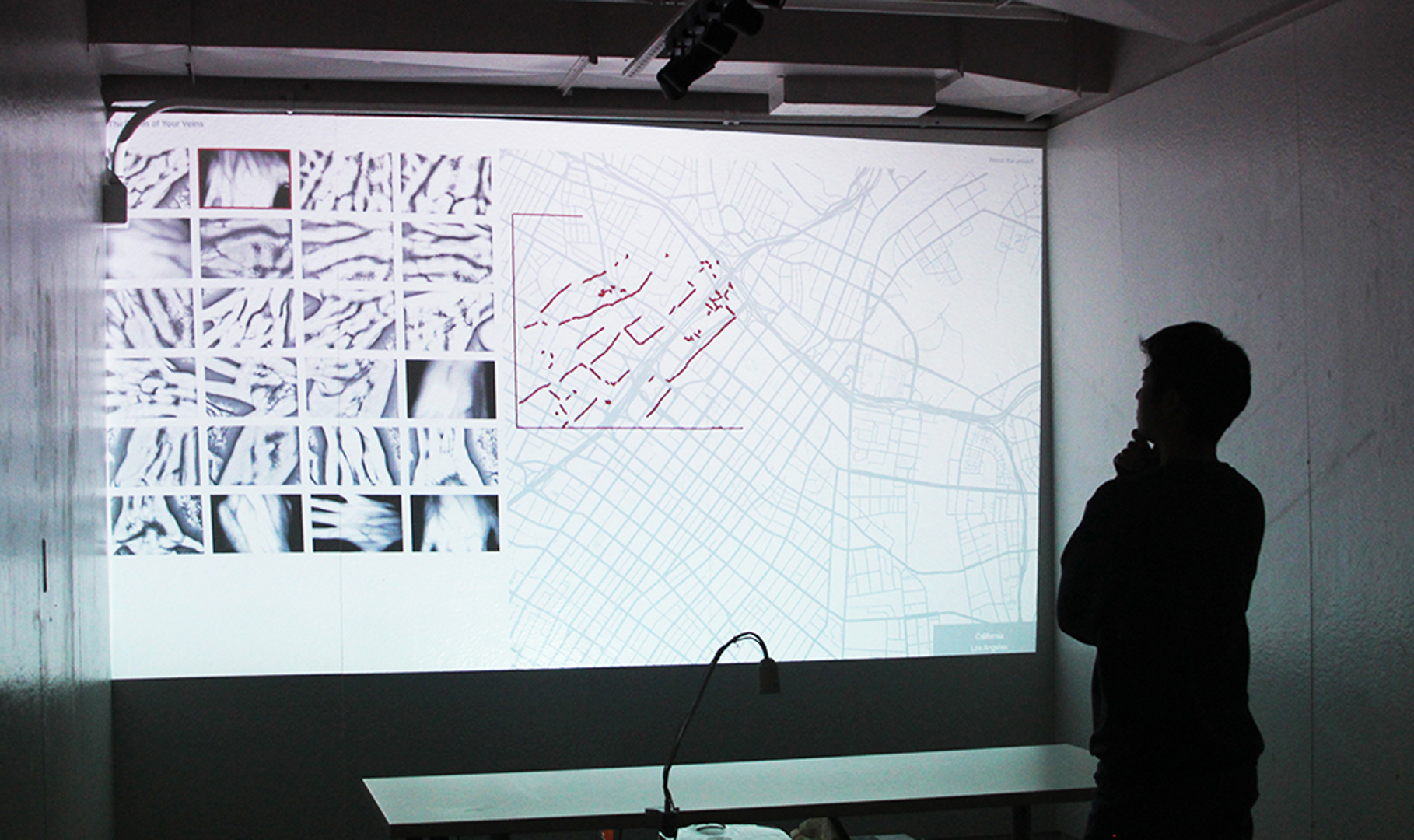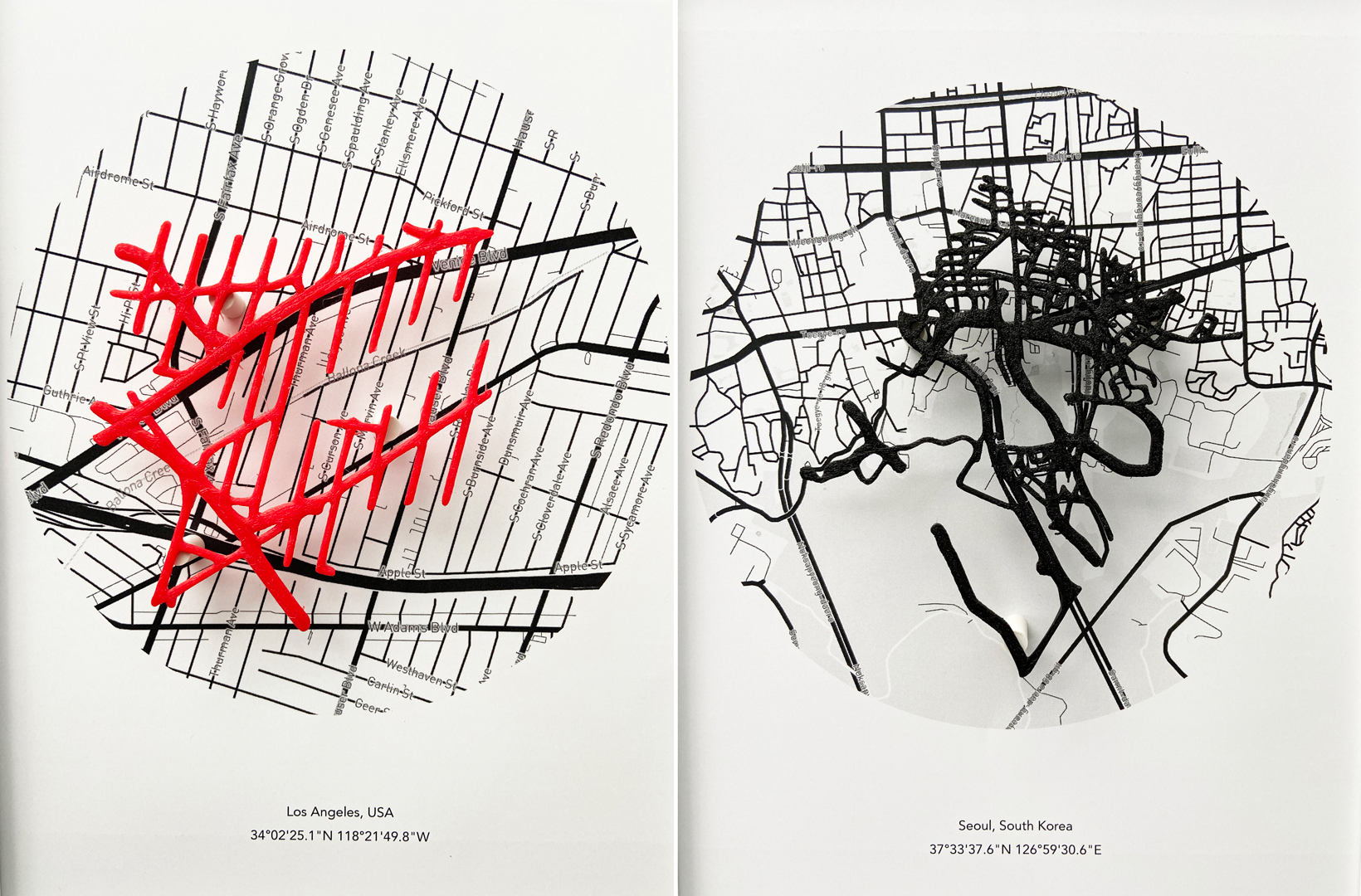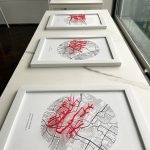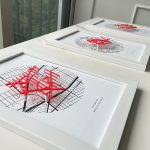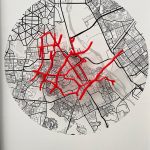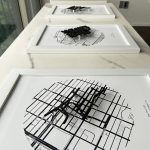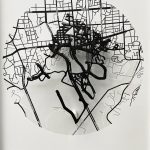Yoon Chung Han, Ryan Cottone, Anusha: Roads In You
Artist(s):
Title:
- Roads In You
Exhibition:
Category:
Artist Statement:
Summary
Roads in You is an interactive biometric-data artwork that allows participants to scan their veins and find the roads that match their vein lines. Users can explore the correlation between individuals and environments using the hidden patterns under the skin and the vein recognition techniques and image processing.
Abstract
The roads of your veins is an interactive biometric-data artwork that allows participants to scan their veins and find the roads that match their vein lines. The vein data as one of the fascinating forms of biometric data contain uniquely complicated lines that resemble the roads and paths surrounding us. The roads resemble how our vein lines are interconnected and how the blood circulates in our bodies in various directions, at various speeds, and in different conditions. This new artwork explores the line segmentation and the structure of veins and compares them to roads in the real world. The participants can also export the data and keep them as a personalized souvenir (3d printed sculptures) as part of the artistic experience. Through this project, users can explore the correlation between individuals and environments using the hidden patterns under the skin and the vein recognition techniques, image processing and artificial intelligence. This project also has the potential to lead the way in the interpretation of complicated datasets while providing aesthetically beautiful and mesmerizing visualizations.
Every person has a different structure of veins in their body. The vein is one of the main sources for biometric data that has been commonly used for various identification devices and software. The complexity and uniqueness of the pattern in the data and the indirect contact during the capturing process are the main strengths of vein data. From an artist’s perspective, I believe meaningful and creative approaches can be explored to find a new correlation between the beautifully intricate vein lines and the objects of a similar form in the real world. Among the various objects and systems that surround us, we chose to use roads in maps due to the similarities of road system design to the lines of a palm or wrist. Inspired by the idea of palmistry, the “the roads of your veins” allow the audience to have an immersive and dynamic experience as well as an aesthetically beautiful outcome. Roads and paths surround the cities and natural environments and are encountered in everyday life, consistently changed by human impact and we always choose where to go from an enormous number of options. The direction, length, and number of roads determine the process of the journey, the starting point, and the final destination. Road constructions have been one of the huge impacts on earth. The questions of the roads and paths, and its impact to our environments have been inspirations for this project.
This work allows us to rethink and reshape on the point of how the nature and our environments resemble our bodies and how we can discover it by technology. The enchantment of discovery is a value of this work and participants can take journeys from their bodies to the world with help of big data, data mining, artificial intelligence and image processing techniques.
Technical Information:
The roads on your veins uses various techniques of image processing and computer vision with an OpenCV library in Python and artificial intelligence. The system first scans a vein image from any part of the human body using an infrared camera. Then, it detects clear lines using line segmentation and Canny edge detection. Once clear lines are extracted, then begins the process of template matching, which matches a scanned vein image as a template to the entire live geo- map data and finds a road(s). Once a road(s) that matches the template (a vein image) is selected, it is highlighted in red as a representation of the veins to show the matched roads to the participants. The participants can also export the data and keep them as a personalized souvenir, 3d printed sculptures as part of the artistic experience. The final results of the whole experience are archived on a website. To increase the rate of success in the template matching process, a threshold to control the similarities of roads is adjusted several times. A higher threshold increases the accuracy of the road data matching the vein data in terms of identical lines. A lower threshold decreases the accuracy of the roads matching the vein lines; however, it allows finding more roads that look similar to the scanned vein lines. Each person has different patterns of veins. Each part of the human body also contains highly unique veins that differ in terms of branches, directions, bifurcations, and length. Therefore, based on the uniqueness of the vein data and the desires of the participants, the thresholds can be controlled to find the best results possible.
Process Information:
This work allows us to rethink and reshape how nature and our environments resemble our bodies and how we can discover it by technology. The enchantment of discovery is a value of this work, and participants can take journeys from their bodies to the world with the help of big data, data mining, and image processing techniques. Based on research, no other works attempted to compare the human veins and map data yet. In this work, biometric data becomes a source of interest, thinking about the uniqueness of genetic information through the personalized art form. This project also has the potential to lead the way in the interpretation of complicated datasets while providing aesthetically beautiful and mesmerizing visualizations.
The biggest challenge we had was the lack of a database for the human vein data. The biometric data is a sensitive one and it is usually very hard to acquire enough amount of test data. While developing the customized software we used limited data but luckily through informal user studies we could get more data for testing and stabilizing the data mapping. The challenging part can be resolved with more user testing and participation of more audience members in future exhibitions.
Other Information:
Inspiration Behind the Project
The uniqueness of biometric data has become the main inspiration and concern addressed in our artwork. Yoon Chung Han, the media artist, has researched and created interactive art installations using two types of biometric data—fingerprints and the iris—over the past seven years. It was natural to move to another kind of biometric data this time. We explored and analyzed the human vein data and used it as art materials. As one of the fascinating forms of biometric data, the vein data contain uniquely complicated lines that resemble the roads and paths surrounding us. The sudden questions behind this project were: what if there are roads in the world that resemble human veins? What if there are interesting connections between the veins and roads? What if the roads are meant to be the destination of your life journey and discoveries of exciting stories? Unlike Yoon’s previous biometric data artworks, this artwork uses map data made by humans. The idea of comparing human body data and human-made data was the primary motive and curious aspect behind this project.
Inspired by the idea of palmistry, the Roads in You allows the audience to have an immersive and dynamic experience and an aesthetically beautiful outcome. Roads and paths surround the cities and natural environments. They are encountered in everyday life, consistently changed by human impact, and we always choose where to go from an enormous number of options. The direction, length, and the number of roads determine the process of the journey, the starting point, and the final destination. Road constructions have been one of the huge impacts on earth. The questions about roads and their impact on our environments have been another inspiration for this project.
Key Takeaways for the Audience
We hope the audience can have a chance to wonder what roads would match their veins. Through this project, users can explore the correlation between individuals and environments using the hidden patterns under the skin and vein recognition techniques and image processing. Even though it will be hard to experience this work in person due to the virtual conference, we hope the audience can check the previously documented results and have a chance to explore a new correlation between the beautifully intricate vein lines and the objects of a similar form in the real world. And we hope to have opportunities to showcase this work on site for the audience in the near future.

